Bob Cianci takes us on an investigation into the culture surrounding the guitar in its most stripped-down, primal form - the homemade cigar box guitar.
| 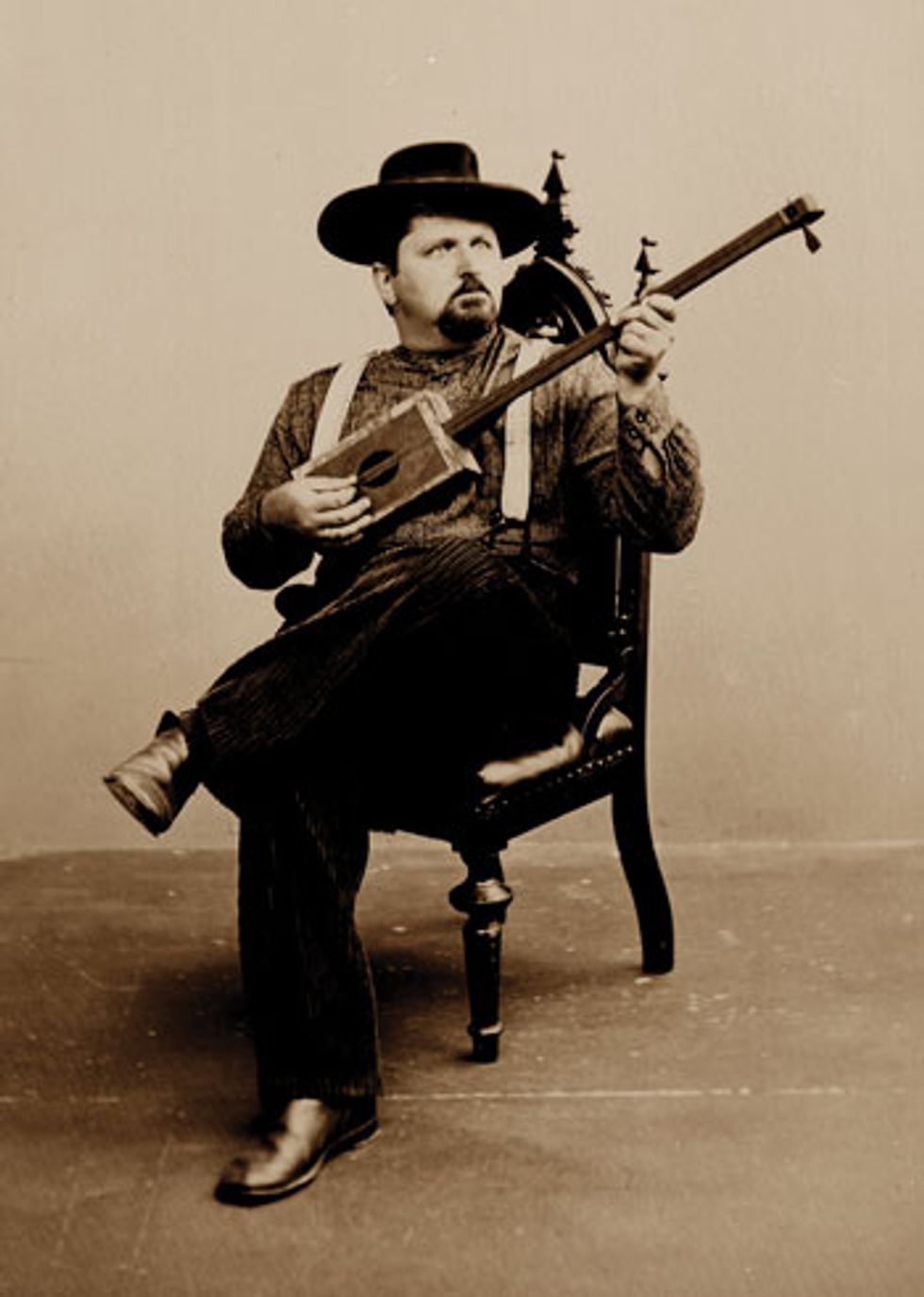 | |
| Shane Speal, photo: Rob Gibson, taken with Civil War-era camera and equipment | ||
Think of it this way—can you really imagine playing raw, feral Delta blues on a $3000 custom-shop guitar and a handwired boutique amp? There’s something painfully wrong with that picture.
| Hear the guitars Free downloads of tracks from Shane Speal's self-titled album: • Tunnel Rat Guitar: 3-string electric CBG by Cigar Box Slim • I Don't Live Today Guitar: 3-string resonator CBG by Pat Cook |
A Little History Lesson
According to Bill Jehle, the foremost collector of antique cigar box guitars, and curator of the Cigar Box Guitar Museum, cigar box instruments date back as far as 1840, as mentioned in the biography of a Mr. Charles A. White. Sketch artist Edwin Forbes published one of his works in Frank Leslie’s Illustrated Newspaper in 1864, depicting two Civil War soldiers entertaining themselves with a cigar box violin. The founder of the Boy Scouts, Daniel Carter Beard, published plans for a cigar box banjo in his 1890 edition of The American Boy’s Handy Book. Cigar box ukuleles were also popular back in the early days.
Bill comments, “Cigar box guitars made their appearance about the same time as the invention of the radio. Broadcast music featuring the guitar was critical. Folks could finally hear the guitar as a lead instrument, and that made the guitar cool. It follows that people wanted to play the guitar, and not being able to afford one naturally lead to building one out of whatever was handy.” It’s notable that cigar box guitars were not just a phenomenon of African-Americans. Rockabilly pioneer Carl Perkins, the son of a dirt-poor tenant farmer, started on a CBG, and he wasn’t alone by any means.
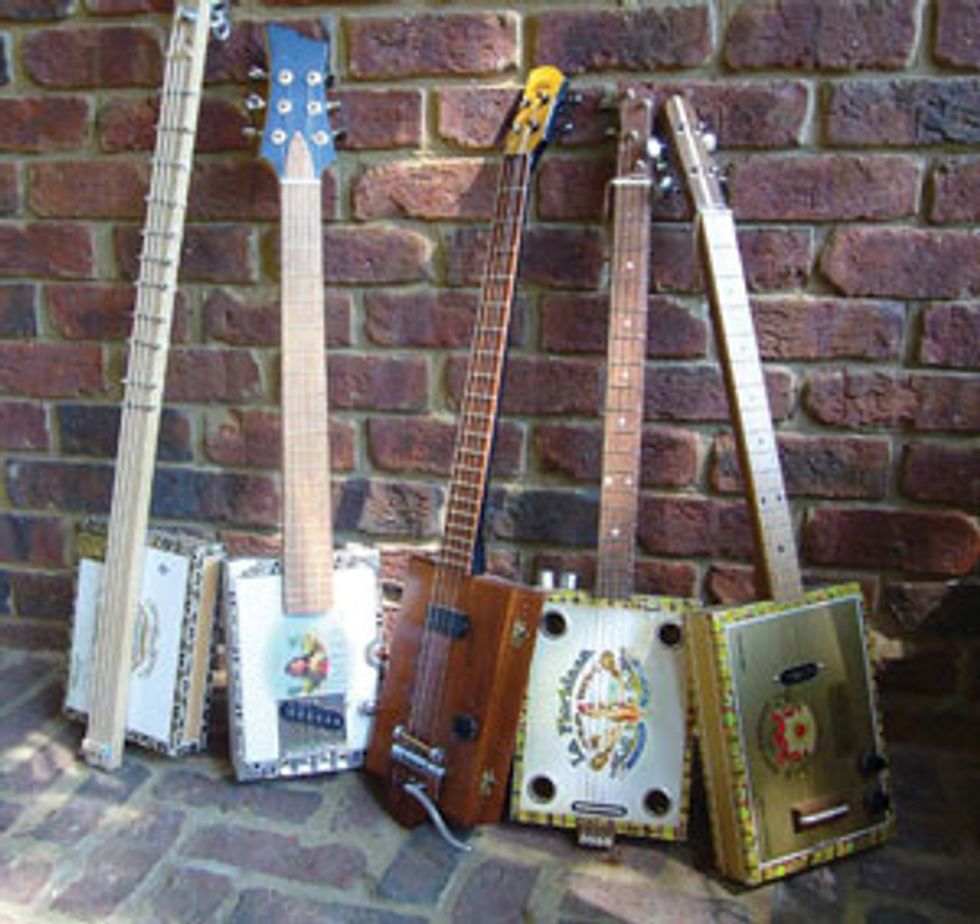 Modern electric cigar box guitars, courtesy of Bill Jehle. From left to right, they are: made by Ed Vogel; Bill Jehle’s Quintero Esquire Tele (short scale; note the converted hex bolt volume knob); made by “Hitone,” founder of guitartree.net (with homemade whammy bar fashioned from cabinet hardware); prototype “Red Dog” by John McNair; made by Jim “Frets” Ferris featuring a hand-wound CigTone pickup by Phil Eggers. |
“When I first started researching cigar box guitar history,” he says, “I had a few I bought on eBay. Shane Speal [more on him later] and I were both working on the history in parallel, so we would frequently exchange information. He emailed me one day to say he was selling the Cigar Box Museum, and I jumped at the offer. There were around 65 different cigar box instruments and all sorts of ephemera. I’ve added more to the collection since then, and it’s up to around one hundred cigar box instruments now. Finding additions to the collection is getting more difficult since more folks know about them now. Any vintage cigar box instrument on eBay is really hard to win, but I’ve also had people willing to sell me instruments for the sake of building up the museum collection. Some people just send me these things because they know it’s going to a good home.”
The King of the Cigar Box Guitar
Shane Speal, a native of York, PA, is the self-appointed King of the Cigar Box Guitar. While he’s certainly not the only practitioner of the instrument, he is universally recognized as the prime mover of the CBG cult, a man who has made it his life’s crusade to spread the word and promote the popularity of CBGs.
“I’m a habitual musical hack,” he told me [Writer’s note: he’s being modest]. “I started on piano and guitar at an early age, played drums in school and played bass in metal bands in the late ‘80s. I discovered blues, Stevie Ray Vaughan and Jimi Hendrix in college and it was all downhill from there. I soon discovered Muddy, the Wolf and Hound Dog Taylor, and slowly worked backwards to the Delta stuff in a quest to find something deeper. Once I hit Blind Willie Johnson, my mind exploded. It was gritty, raw, and meaner than any heavy metal I ever heard. By the time I entered that Delta blues phase, I was playing a beat-to-hell Stella guitar with bad action and a bottleneck slide. Then, in 1993, I came across an interview with Carl Perkins where he described the simple two-string cigar box guitar he learned on, and I just had to build one.” “I got fancy and gave it three strings, and used a spark plug socket as a slide. Just a few weeks prior, I had been killing myself trying to play Sylvester Weaver’s ‘Guitar Rag’ on my acoustic. When I finished the three-stringer, that song just flowed out. It had the sound of grit, dirt and sweat of the Delta.”
“A CBG is quirky and appears ‘broken’ from the start. They just don’t look like they should play any music. I love to see jaws hit the floor when I shove a socket on my finger and wail away.” According to Bill Jehle, “Shane sounds like Motörhead in a jug band!” When questioned why he named himself the “King of the Cigar Box Guitar,” Shane replies, “It’s a celebration of absurdity. Who would ever want to call himself the king of such a shitty instrument?”
“I have many normal guitars in my studio, but I only use them as backing instruments while recording. The rest of the CD is CBGs and my evil ‘Mailbox Dobro,’ which is made from an actual black metal mailbox. I am a cigar box guitarist. I’m just not interested in status quo instruments anymore.”
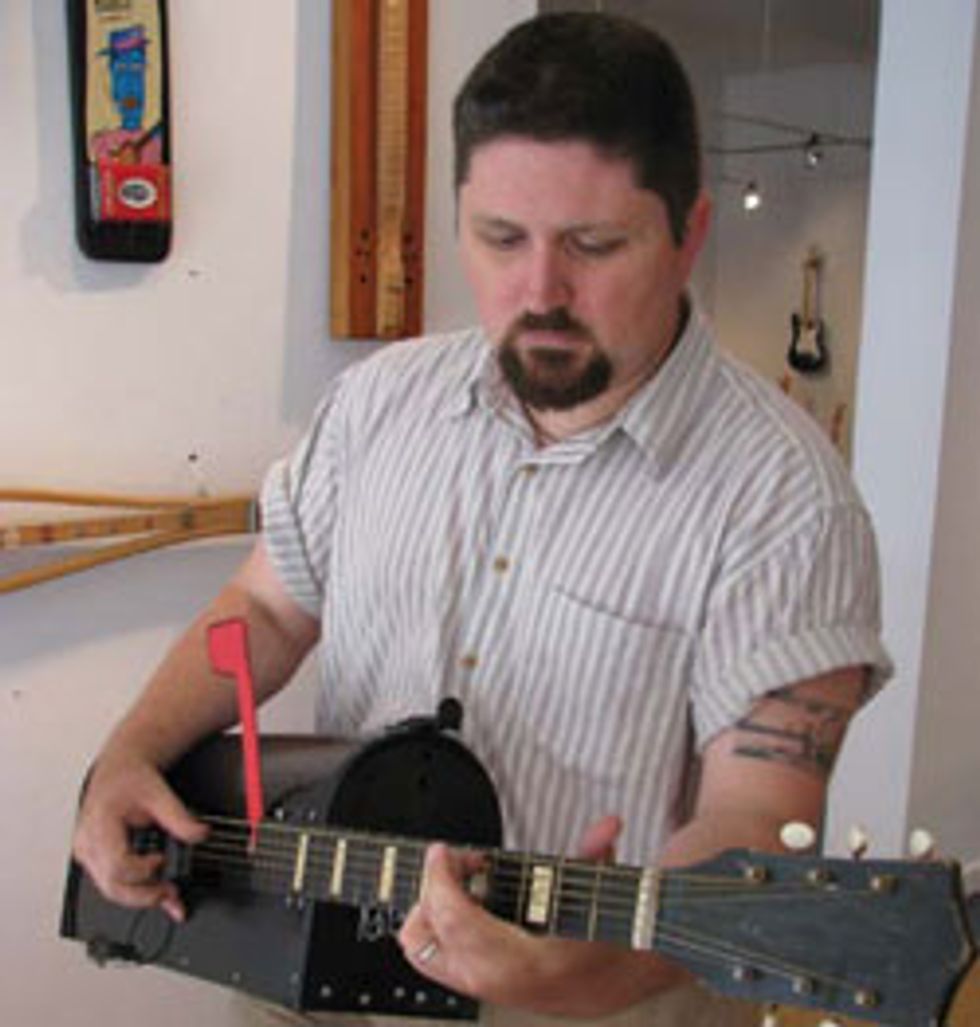 Shane Speal with his Mailbox Dobro. |
But why has this cult formed around these primitive instruments? Shane remarks, “There are no rules as far as building or playing CBGs. If you can dream it, then do it. There is an army of CBG’ers encouraging new recruits to build their own. While the rest of the world is rehashing Eric Clapton and Pink Floyd tablature, we’re blazing new trails. We’re writing history as we go along.” Shane now runs a website called CigarBoxNation.com that boasts over six hundred active members at this writing. The old Yahoo/Group forum has over three thousand members. Boy Scouts and Cub Scouts are now building CBGs for badges. Tom Waits and P.J. Harvey have used CBGs on their albums. Billy Gibbons even plays them.
As to the future of the CBG, Shane proposes, “The future is friends… more friends. None of us expect to make ‘the big time’ from this. The ‘big time’ doesn’t exist anymore due to the destruction of the record business and the horrible conglomeration of the radio industry. Music has been thrust back into a more regionalized stage, where performers are their own booking agents and record companies. This is an amazing thing. With a home computer, we now control our own printing press, recording studio and networking system. I have my own record label, insurrectionrecords.com, and I sell my homemade instruments on shanespeal.bigcartel.com. The cigar box guys are using computers, and quite effectively. We have our own indie labels, magazines, festivals, social network, and a dedicated family that will do anything to help each other out. This is the future of CBGs and the whole music industry.”
Movers & Shakers & Cigar Box Heroes
Shane Speal, while the acknowledged leader of the CBG movement, is by no means its only practitioner.
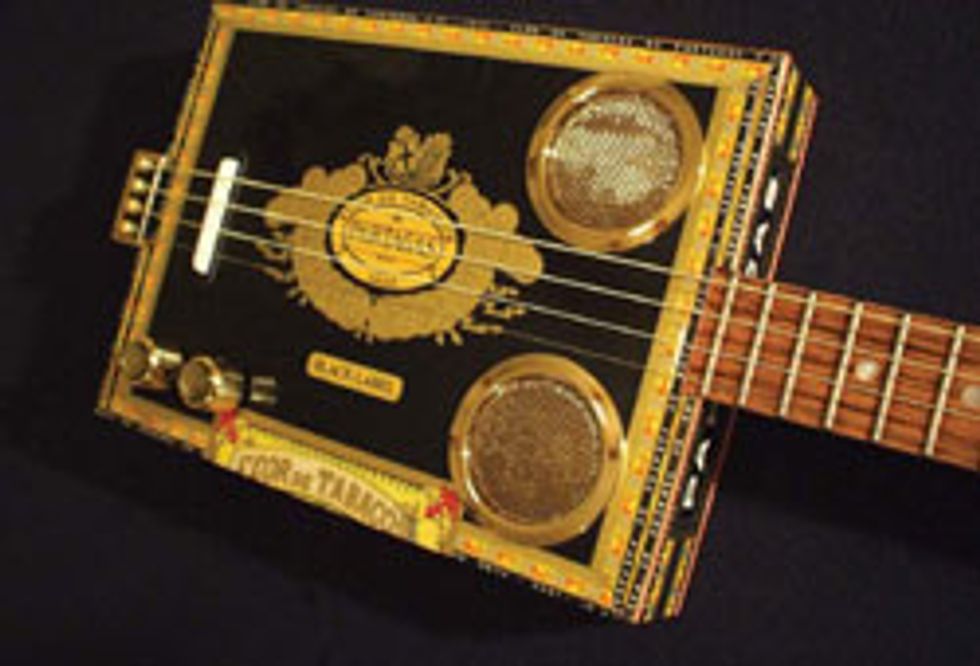 Photo courtesy of John McNair. |
On the CBG phenomena, Williams comments, “Making and playing homemade instruments has allowed me to find my own musical voice, and to express myself without feeling the need to imitate an established musician. I don’t view the cigar box/homemade music community as a cult, but rather as a far-flung group of people from all walks of life who are passionate and supportive about helping others to make something that is uniquely their own...” Williams also records under his given name, and has also released two CDs of vintage, historical diddley bow recordings by other artists.
Ted Crocker is a luthier and guitar case maker in southern New Jersey. He constructed the crude but hip solidbody guitar used in the recent film Honeydripper starring Danny Glover as the owner of a failing juke joint saved by a young guitarist who comes with a homemade guitar offering to play. You can buy a Honeydripper guitar just like the one used in the movie. The shape is close to the famous Bo Diddley rectangular instrument with a couple of alterations. Ted also makes a guitar called the Six Banger (which slightly resembles a Telecaster) with one single-coil pickup. Shane Speal owns the prototype, and I have played it. It’s one badass slide guitar, and it’s priced right, starting at five hundred bucks.
Ted also makes various cigar box guitars, plus the Terraplane footboard stomper, wooden guitar picks, and his own Stonehenge brand pickups, which are available in one to six string configurations. You can find Ted’s pickups and accessories on Ebay, or you can purchase them directly through his website: tedcrocker.com.
Ben Prestage is a one-man-band who plays CBGs and is also an extremely busy artist who tours constantly, keeping up a punishing schedule that includes a trip to Europe this summer. His five rootsy-bluesy CDs are available on his MySpace page, and he has numerous videos up on YouTube. Prestage is also considered one of the leading CBG exponents.
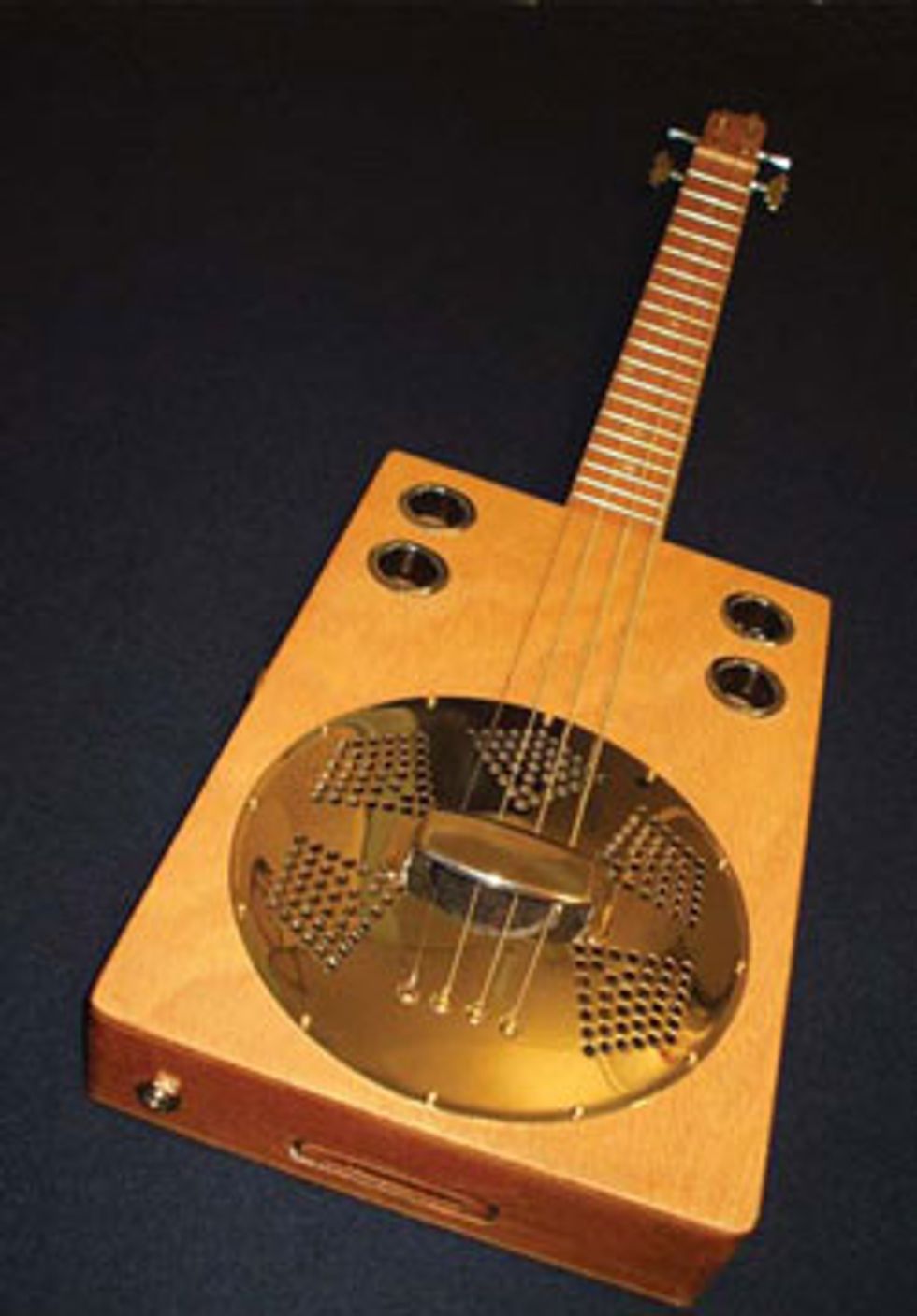 The Hound Dog from Red Dog Guitars. Photo courtesy of John McNair. |
Richard Johnston is a Memphis street musician and one-man band who plays his own brand of traditional northern Mississippi hill country blues, in the style of R.L. Burnside and Junior Kimbrough. Johnston has been tapped as the next young musician capable of turning young people on to the blues, as Stevie Ray Vaughan did years ago. Johnston was the subject of a recent film, Richard Johnston: Hill County Troubador, directed by documentary filmmaker Max Shores.
Max Shores also recently completed another documentary on CBGs, Songs Inside the Box, which features many of the musicians mentioned in this article. “I really didn’t have much appreciation for CBGs before I heard Richard Johnston play one,” Shores remarks. “I am amazed by the wonderful music people are making with CBGs, and the level of expression many builders display. I am also deeply moved by the joy people have found through these instruments and the camaraderie that has developed as CBG makers and players have networked through the Internet…. When they play their CBGs, many of them expose eccentric characteristics that might otherwise remain hidden, because the CBG gives them license to do so. These are great people making great art and music and having the time of their lives doing so. My life has been enriched by getting to know these folks.” Learn more at: songsinsidethebox.com.
Gerry Thompson is a singer, songwriter and guitarist, and another leading light of the CBG movement. Gerry lived life on the edge in an alcoholic haze for twenty years before getting clean in 1989. He has settled down, gone to college, married, and has survived two liver transplants. Gerry stumbled onto the CBG after trying to play a poorly made mando-banjo. He attended the first CBG festival in Carrolton, KY, in 2000, and was coaxed onstage by CBG builder Kurt Schoen. Thompson, who had never performed in public before and only had three songs prepared, was a hit. His music is reminiscent of early Bob Dylan, and is lyrical, poignant and very melodic, with lyrics drawn from his life experiences.
“I quit drinking a year before I got sick,” he says. “The doctors said I had less than a year to live. I’m in a weird state of grace, I guess. The transplant changed me. I started having dreams that were mine, but I wasn’t in them. A decade after the transplant, I just started (playing)… they all started coming out as songs. It’s simple, primal. I just tell stories about my life. Freedom. That’s what the cigar box guitar gave me. That’s what it’s all about.”
Dave Gallaher, aka Microwave Dave, is a talented Alabama-based bluesman who effectively incorporates CBGs into his electric and acoustic shows, as well as an instrument called the Lowebow, invented by Memphis music store owner and guitarist Johnny Lowe, better known as “Johnny Lowebow.” The Lowebow is a doubleneck CBG with one bass string and three guitar strings. Played with a slide, the Lowebow is a deadly weapon in the right hands, allowing the player to be both guitarist and bassist at the same time.
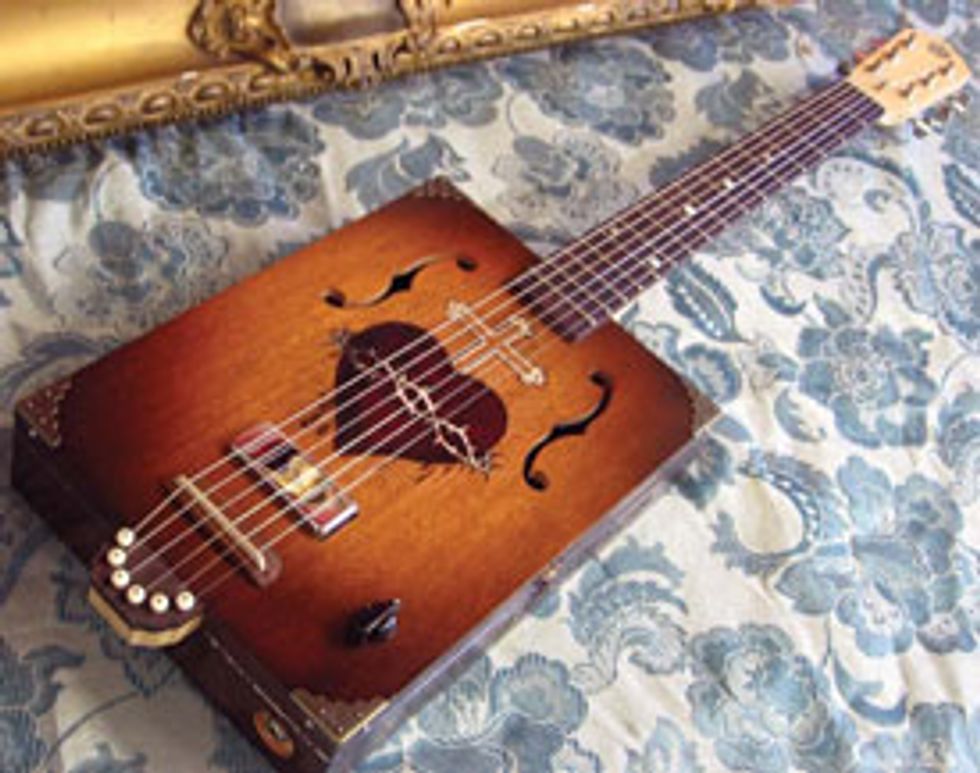 The Dolorosa 6-string model from Daddy Mojo. Photo courtesy of Lenny Piroth-Robert. |
And finally, Daddy Mojo, aka Lenny Piroth-Robert, of Montreal, Quebec, Canada, makes custom-made, professional-quality CBGs in his shop, along with his partner and two employees. The Dolorosa model in particular, with its screenprinted heart/cross/barbed wire artwork is an absolute stunner, as are the Vargas-inspired pinup models. Visit their website: daddy-mojo.com.
Wrapping It All Up
Admittedly, this writer comes from the traditional school of guitar thought. You go to a music store (or eBay), buy a guitar, plug into your high-quality tube amp and stompboxes and play, usually imitating your axe-wielding heroes. All that changed to a great extent after I became aware of the CBG movement and began to dig deeper in preparation for this article. I’m not saying that cigar box instruments are going to force me to put all my treasured guitars up for sale, but CBGs now have a place in my arsenal of sounds, and I have made several new friends in the process. Visit the websites. Listen to the music, talk to the players and builders. Open your mind and soul to the world of the cigar box guitar. You may never be the same.
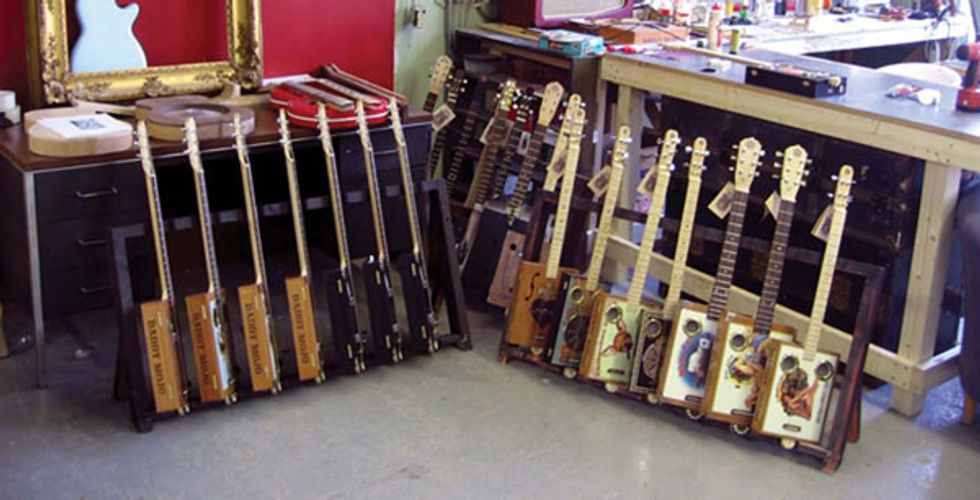 The Daddy Mojo shop. Photo courtesy of Lenny Piroth-Robert. |
(The author wishes to thank Shane Speal, Ted Crocker and Eric Baker for their input and generosity, as well as all the CBG enthusiasts, builders and players who helped contribute to this piece).
